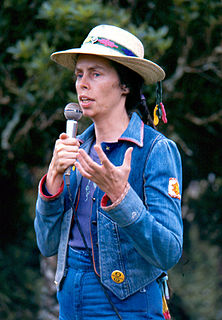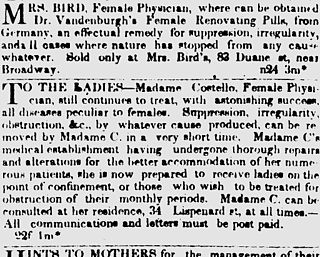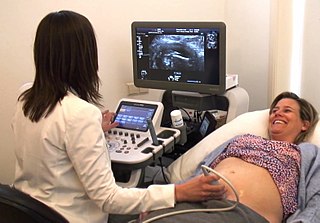Related Research Articles

Midwifery is the health science and health profession that deals with pregnancy, childbirth, and the postpartum period, in addition to the sexual and reproductive health of women throughout their lives. In many countries, midwifery is a medical profession. A professional in midwifery is known as a midwife.
Obstetrics is the field of study concentrated on pregnancy, childbirth and the postpartum period. As a medical specialty, obstetrics is combined with gynecology under the discipline known as obstetrics and gynecology (OB/GYN), which is a surgical field.

Childbirth, also known as labour or delivery, is the ending of pregnancy where one or more babies leaves the uterus by passing through the vagina or by Caesarean section. In 2015, there were about 135 million births globally. About 15 million were born before 37 weeks of gestation, while between 3% and 12% were born after 42 weeks. In the developed world most deliveries occur in hospitals, while in the developing world most births take place at home with the support of a traditional birth attendant.

A doula is a trained companion who is not a healthcare professional and who supports another person through a significant health-related experience, such as childbirth, miscarriage, induced abortion or stillbirth, or non-reproductive experiences such as dying. A doula may also provide support to the client's partner, family, and friends.

The postpartum period begins immediately after childbirth as the mother's body, including hormone levels and uterus size, returns to a non-pregnant state. The terms puerperium, puerperal period, or immediate postpartum period are commonly used to refer to the first six weeks following childbirth. The World Health Organization (WHO) describes the postnatal period as the most critical and yet the most neglected phase in the lives of mothers and babies; most maternal and newborn deaths occur during this period.

Pregnancy, also known as gestation, is the time during which one or more offspring develops inside a woman's womb. A multiple pregnancy involves more than one offspring, such as with twins. Pregnancy usually occurs by sexual intercourse, but can also occur through assisted reproductive technology procedures. A pregnancy may end in a live birth, a spontaneous miscarriage, an induced abortion, or a stillbirth. Childbirth typically occurs around 40 weeks from the start of the last menstrual period (LMP). This is just over nine months. When using fertilization age, the length is about 38 weeks. An embryo is the term for the developing offspring during the first eight weeks following fertilization, after which the term fetus is used until birth. Signs and symptoms of early pregnancy may include missed periods, tender breasts, morning sickness, hunger, and frequent urination. Pregnancy may be confirmed with a pregnancy test. Methods of birth control—or, more accurately, contraception—are used to avoid pregnancy.

Ina May Gaskin is an American midwife who has been described as "the mother of authentic midwifery." She helped found the self-sustaining community, The Farm, with her husband Stephen Gaskin in 1971 where she markedly launched her career in midwifery. She is known for the Gaskin Maneuver, has written several books on midwifery and childbirth, and continues to educate society through lectures and conferences and spread her message of natural, old-age inspired, fearless childbirth.

Unassisted childbirth (UC) refers to the process of intentionally giving birth without the assistance of a medical birth attendant. It may also be known as freebirth, DIY (do-it-yourself) birth, unhindered birth, and unassisted home birth. Unassisted childbirth is by definition a planned process, and is thus distinct from unassisted birth due to reasons of emergency, lack of access to a skilled birth attendant, or other. It is also different from homebirth, although most UCs also happen within the home.

The practice of induced abortion—the deliberate termination of a pregnancy—has been known since ancient times. Various methods have been used to perform or attempt abortion, including the administration of abortifacient herbs, the use of sharpened implements, the application of abdominal pressure, and other techniques. A naturally occurring abortion that ends a pregnancy sometimes is described as a "spontaneous" abortion or, with the more frequently used popular euphemism, "miscarriage", to distinguish a difference between an induced abortion and a naturally occurring one, but medically, abortion is the terminology applied to either natural or induced.

Sheila Helena Elizabeth Kitzinger MBE was a British natural childbirth activist and author on childbirth and pregnancy. She wrote more than 20 books and had a worldwide reputation as a passionate and committed advocate for change.

Abortion in South Africa is legal on request during the first 12 weeks of pregnancy, and under certain conditions afterwards. Abortion is provided free at government hospitals and a tele-medical or 'pills by post' service is provided by Marie Stopes South Africa and Abortion Clinic Johannesburg. Abortion was legal only under very limited circumstances until 1 February 1997, when the Choice on Termination of Pregnancy Act came into force, providing abortion on demand for a variety of cases.
The term childbirth positions refers to the physical postures the pregnant person may assume during the process of childbirth. They may also be referred to as delivery positions or labor positions.
Abortion in Italy became legal in May 1978, when Italian women were allowed to terminate a pregnancy on request during the first 90 days. A proposal to repeal the law was considered in a 1981 referendum, but was rejected by nearly 68% of voters; another referendum aimed at eliminating the restrictions was rejected by 88.4%.
Debra Evans is an American writer known for her books on issues related to contemporary Christian spirituality, reproductive health, women's wellness, and family relationships. She has written over 22 non-fiction books.
The following outline is provided as an overview of and topical guide to obstetrics:

Squatting is a versatile posture where the weight of the body is on the feet but the knees and hips are bent. In contrast, sitting involves taking the weight of the body, at least in part, on the buttocks against the ground or a horizontal object. The angle between the legs when squatting can vary from zero to widely splayed out, flexibility permitting. Another variable may be the degree of forward tilt of the upper body from the hips. Squatting may be either full or partial.
Doris Clifton Gordon was a New Zealand doctor, university lecturer, obstetrician and women's health reformer. She was known as 'Dr Doris', famous for her work in rural general practice, for raising the status of obstetrics, improving obstetrics education of medical students and doctors, and working for the welfare of mothers and children.

Prolonged labor is the inability of a woman to proceed with childbirth upon going into labor. Prolonged labor typically lasts over 20 hours for first time mothers, and over 14 hours for women that have already had children. Failure to progress can take place during two different phases; the latent phase and active phase of labor. The latent phase of labor can be emotionally tiring and cause fatigue, but it typically does not result in further problems. The active phase of labor, on the other hand, if prolonged, can result in long term complications.

A midwife is a health professional who cares for mothers and newborns around childbirth, a specialization known as midwifery.

Pain management during childbirth is the treatment or prevention of pain that a woman may experience during labor and delivery. The amount of pain a woman feels during labor depends partly on the size and position of her baby, the size of her pelvis, her emotions, the strength of the contractions, and her outlook. Tension increases pain during labor. Virtually all women worry about how they will cope with the pain of labor and delivery. Childbirth is different for each woman and predicting the amount of pain experienced during birth and delivery can not be certain.
References
- ↑ See Kerreen Reiger, "Telling Tales: Health Professionals and Mother's Constructions of Choice in Childbirth," Sociological Sites/Sights, TASA 2000 Conference, Adelaide: Flinders University, Dec. 6-8, 2000 (note 1).
- ↑ Childbirth Choices Guide: Janet Balaskas - Active Birth Laura Stavoe Harm
- ↑ Christiane Northrup, Tori Hudson (1999). Women's Encyclopedia of Natural Medicine: Alternative Therapies and Integrative Medicine. McGraw-Hill Professional. ISBN 0879837888.
- ↑ Susan Seneman, "Rebirthing Midwifery," New Directions for Women, v. 22, n. 4, pp. 7 (July-Aug. 1993)
- ↑ Seven ways to survive pregnancy The Guardian (August 12, 2006)